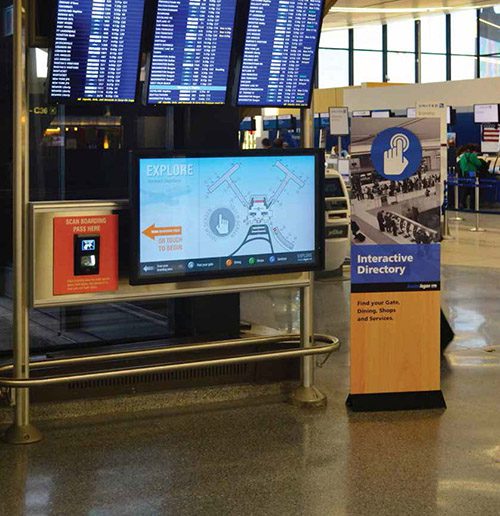 What began as a digital signage initiative at Boston Logan International Airport (BOS) has evolved to include an industry first: boarding pass scanners that help direct passengers to their gates and deliver information about flight updates and concessions’ options along the way. The innovative wayfinding/flight information/marketing combo is not only improving the passenger experience at BOS, it’s also inspiring airports around the country to follow suit.
What began as a digital signage initiative at Boston Logan International Airport (BOS) has evolved to include an industry first: boarding pass scanners that help direct passengers to their gates and deliver information about flight updates and concessions’ options along the way. The innovative wayfinding/flight information/marketing combo is not only improving the passenger experience at BOS, it’s also inspiring airports around the country to follow suit.
Three interactive scanners went live in BOS’ Terminal C late last year, and additional larger iterations of the technology are already planned for other areas in the airport. Maria Itati Moguilner, passenger information systems supervisor at the Massachusetts Port Authority (Massport), watched intently as customers began discovering the airport’s new feature. One of the first to use the new boarding pass scanner was a child, no more than 12 years old, recalls Moguilner: “He walked up to the screen, began touching it and showing his parents, then turned around and asked, “Can we go to Johnny Rockets?”
|
factsfigures
Project: Digital Signage |
Moguilner says the BOS staff expected a learning curve with the use of the boarding pass scanner, but not as much with the screens, as many people use touchscreen tablet devices. An orange frame was placed around the scanner to draw attention to it and help passengers recognize that it offers a unique function. When passengers scan their boarding passes, the system welcomes them by name, provides their gate number and indicates their flight status. The screen then shows an animated path to their specific gate and highlights amenities available along the way, including restaurants and shopping. It even provides weather information about passengers’ destination cities.
“The robust functionality allows the boarding pass scanner to do so much more as it integrates with interactivity and wayfinding,” says Christopher Hill, senior sales executive at software provider Four Winds Interactive.
 The scanner tracks both screen touches and the number of boarding passes scanned. At press time, the statistics had not been thoroughly reviewed yet, but Moguilner was looking forward to having such useful information. Some passengers are confused when they first see the scanner but are intrigued once they realize how it works, she explains. “This is really cool!” is a common reaction, she adds.
The scanner tracks both screen touches and the number of boarding passes scanned. At press time, the statistics had not been thoroughly reviewed yet, but Moguilner was looking forward to having such useful information. Some passengers are confused when they first see the scanner but are intrigued once they realize how it works, she explains. “This is really cool!” is a common reaction, she adds.
 “It’s very simple and streamlined for the user,” says Colleen Hamilton, principal at Art of Context, the firm that designed the system’s content. Passengers naturally clutch their boarding passes in their hands as they travel through airports, so the system is a “natural fit,” she adds.
“It’s very simple and streamlined for the user,” says Colleen Hamilton, principal at Art of Context, the firm that designed the system’s content. Passengers naturally clutch their boarding passes in their hands as they travel through airports, so the system is a “natural fit,” she adds.
Quick Turnaround
The timeline for installing the new scanners was notably tight, recalls Moguilner, who managed the project for Massport. Although the overall signage initiative kicked off in June 2012, the project was well underway before the boarding pass scanner element was added. “As we defined the program, we saw there was much other opportunity,” explains Manik Arora, president and CEO of Arora Engineers. “It was not necessarily based around revenue generation, but enhancing the level of service and passenger experience.”
Moguilner and Arora presented the technology at the annual conference for Airports Council International – North America in September 2013. Then, they proposed installation at BOS to Massport’s chief information officer, Francis Anglin, who immediately recognized the value of the system and authorized the project to be completed before the end of the year. The first scanners went live on December 30, barely meeting contractors’ year-end commitments. 
Hamilton says that installing scanners in one part of the terminal offered BOS the opportunity to see what works and what doesn’t before debuting the equipment throughout the airport. “We really believe in the concept of piloting, doing passenger studies and rolling that information into our next version,” she explains.
Jason Shevrin, a project executive at Arora Engineers, agrees, noting BOS was “very mature” in the way it approached the process — especially for an airport that previously didn’t have digital signage. Establishing this plan now, he adds, will benefit BOS for years to come: “Every time they do a capital improvement project, they know what they want to do, the content, configuration of the displays and hardware. It was a really good experience for everybody.”
The new technology could create a fundamental shift in how passengers navigate airports, notes Arora. Currently, most passengers view their journey from gate to curb, and curb to gate, as linear. In reality, he counters, we “live in a world of figure eights and circles.” BOS’ new boarding pass scanners will help define points along those curves and circles where customer service can be increased, information can be push or pulled, and eventually opportunities for revenue can be added.
From a content standpoint, Hamilton notes that it will be important to keep every customer touch point at BOS consistent — from the airport’s website, to its mobile app, and onsite with the new digital signage. Massport wants the same interface to be available at home, on the road and in the airport. “If a person is pre-planning their visit at home, we don’t want them presented with something totally different when they come to airport,” she explains.
Behind the Scenes
Shevrin says preliminary work BOS personnel did made the tight installation timetable achievable. Their process of detailed research, planning, installation and another follow-up round of research also made the overall signage program highly effective, he relates. According to Shevrin, top-tier airports are now making signage a holistic program within their facilities.
Moguilner agrees that the research was a particularly important piece of the project. “The truth of the matter is that the first time, we developed the content blind,” she acknowledges. “We put out what we thought was needed, and while 80 percent was on track, there were other things we didn’t think would be such a big deal and were.”
Last summer, however, BOS hired Cercone Brown Co. to conduct five-question interviews with a variety of passengers — moms, students, businesspeople, etc. — while they waited for their bags. The results were eye-opening, Moguilner recalls: “It took them three to four minutes to find where they were on the map, another three to four minutes to find what they wanted, and another one to two minutes to find how to get there.”
The research also revealed that BOS passengers prefer to see information about local current events in the baggage claim area, rather than historical Boston photos or news feeds. A second survey will be conducted later this year.
Reviewing the videotaped interviews “takes time, but it’s worth it,” says Moguilner. “Like any business, it’s getting in touch with your customers.”
Like Shevrin, Arora also highlights the importance of the airport’s research and pre-installation planning: “They (BOS) respect the process but also understand that you have to go through the process. If you want to only sell advertising, then the ‘hang and bang’ approach is your priority. If you want to increase the level of service, however, you have to go through some measurement of what you want to accomplish.”
When it comes to airport wayfinding and signage, one size never fits all, adds Arora.
Dynamic Data
With 27 new digital displays and three interactive boarding pass scanners operating in Terminal C, BOS’ seven-gate expansion of Terminal B is currently underway. It includes the installation of 88 new digital displays and four interactive video walls. Terminal E will follow, with another 40 displays, a complete replacement of the existing flight information display banks, and a boarding pass scanner in an interactive video wall that is designed to accommodate arriving international passengers making connections to national flights.
The synchronization of various individual data feeds provided by the new system is a big bonus for BOS, notes Hamilton. Concessions and gate information is layered, so if a gate change is made on the website, the same change is immediately updated to the digital signage. “It is all data driven, which is really unique — almost as much as the boarding pass aspect,” she explains. Although the technology has been previously used for mobile and web applications, this is its first use in digital signage, Hamilton adds.
Four Winds Interactive, the software provider, highlights the revenue implications. “While providing an enjoyable passenger experience is important for all airport executives, we know driving the bottom line is essential,” says Hill. “BOS made it easier for passengers to locate amenities with step-by-step directions, which in turn, increased foot traffic to terminal locations.”
Adding the new signage allows BOS to promote concessions information in a powerful format that captures passengers’ attention and increases the likelihood of purchases, he explains.
According to Moguilner, executives at the airport’s two main concessionaires are very excited about the new technology and foresee enormous potential with its application. After installation, they were eager to learn about how their companies can work with Massport to incorporate restaurant specials, menus and information about store sales integrated into the content passengers see on the way to their gates.
Arora predicts that the new data-driven system at BOS could eventually expand even further to include passenger loyalty programs and concierge services — elements that will boost passenger loyalty and provide a new non-aeronautical revenue stream for the airport. There is money to be made, he notes, even if only 10% of the airport’s 30 million passengers opt to pay for a yearly subscription to receive exclusive information about the best parking spots, discounts at high-end retailers, etc.
Customer service is the hook, adds Arora, echoing Massport’s guiding philosophy. Given the technology’s immediate benefits and future potential, Arora is not surprised by the attention BOS’ boarding pass scanners is garnering. The company is already working with a major U.S. International airport on a similar system, and numerous others are expressing interest as well.


